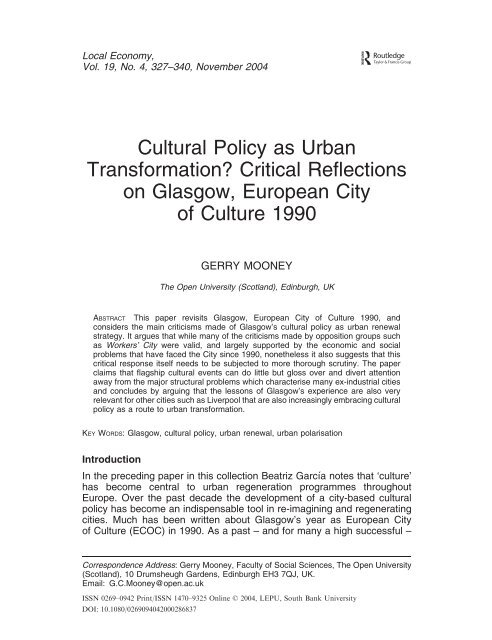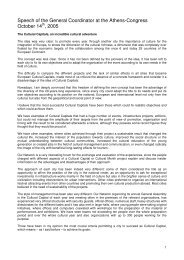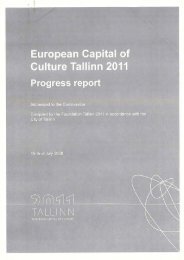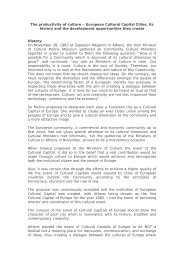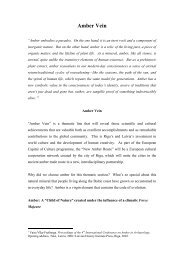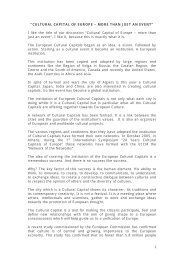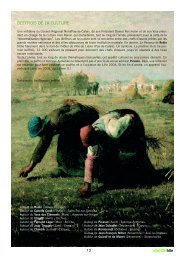Cultural Policy as Urban Transformation? Critical Reflections on ...
Cultural Policy as Urban Transformation? Critical Reflections on ...
Cultural Policy as Urban Transformation? Critical Reflections on ...
Create successful ePaper yourself
Turn your PDF publications into a flip-book with our unique Google optimized e-Paper software.
330 Gerry Mo<strong>on</strong>eyby the large council estates that are such a notable, if marginalised, featureof the City’s urban landscape.Whose Culture? Whose Gl<str<strong>on</strong>g>as</str<strong>on</strong>g>gow? Revisiting the Critique of 1990The 1990 agenda, set by the municipal authorities, w<str<strong>on</strong>g>as</str<strong>on</strong>g> fixed <strong>on</strong> <str<strong>on</strong>g>as</str<strong>on</strong>g>traightforward premise, that the European City of Culture w<str<strong>on</strong>g>as</str<strong>on</strong>g> both anaffirmati<strong>on</strong> of Art and an affirmati<strong>on</strong> of Gl<str<strong>on</strong>g>as</str<strong>on</strong>g>gow: thus if you were opposedto the first you were opposed to the other two. So the Workers’ City Groupw<str<strong>on</strong>g>as</str<strong>on</strong>g> presented <str<strong>on</strong>g>as</str<strong>on</strong>g> an unpatriotic bunch of philistines, the ghost of Stalinistp<str<strong>on</strong>g>as</str<strong>on</strong>g>t and workerist future. By drawing attenti<strong>on</strong> to certain awkward realitieswe encountered a quite remarkable venom. (Kelman, 1992, p. 1)This comment from James Kelman is <str<strong>on</strong>g>as</str<strong>on</strong>g> relevant now <str<strong>on</strong>g>as</str<strong>on</strong>g> it w<str<strong>on</strong>g>as</str<strong>on</strong>g> for theperiod around 1990 (and it will also surely be of some relevance forthose who seek to questi<strong>on</strong> some of the claims that are already beingmade about what ECOC will do for Liverpool in 2008). A notableScottish writer, Kelman w<str<strong>on</strong>g>as</str<strong>on</strong>g> a leading member of the ‘Workers’ City’group, am<strong>on</strong>g the most vociferous opp<strong>on</strong>ents of all that Gl<str<strong>on</strong>g>as</str<strong>on</strong>g>gow ECOC1990 represented. And the venom that Kelman refers to h<str<strong>on</strong>g>as</str<strong>on</strong>g> hardlydissipated. At a seminar <strong>on</strong> Gl<str<strong>on</strong>g>as</str<strong>on</strong>g>gow’s ‘Changing Internati<strong>on</strong>al Appealat the end of January 2004, it w<str<strong>on</strong>g>as</str<strong>on</strong>g> not surprising to hear <strong>on</strong>e of thekeynote speakers referring to Workers’ City <str<strong>on</strong>g>as</str<strong>on</strong>g> ‘self-appointed representativesof Gl<str<strong>on</strong>g>as</str<strong>on</strong>g>gow people, Stalinists who argued that ordinaryGl<str<strong>on</strong>g>as</str<strong>on</strong>g>gow folk were not for 1990. But they were wr<strong>on</strong>g’. Those who havedared to questi<strong>on</strong> or attack the urban ‘renewal’ strategies that have beenadopted in Gl<str<strong>on</strong>g>as</str<strong>on</strong>g>gow since the mid-1980s often find themselves <strong>on</strong> thedefensive, perceived <str<strong>on</strong>g>as</str<strong>on</strong>g> heretics questi<strong>on</strong>ing some universal truth. Thereare some positive changes that critics would acknowledge: arguablyGl<str<strong>on</strong>g>as</str<strong>on</strong>g>gow h<str<strong>on</strong>g>as</str<strong>on</strong>g> a better reputati<strong>on</strong> today than it did in the period prior tothe late 1980s; many ‘ordinary’ Gl<str<strong>on</strong>g>as</str<strong>on</strong>g>wegians attended 1990 eventsand festivals; having exhibiti<strong>on</strong>s, c<strong>on</strong>ferences, large cultural events, newmuseums, new art centres etc created opportunities of varied andmultiple kinds for some Gl<str<strong>on</strong>g>as</str<strong>on</strong>g>wegians; jobs have been created in thearts and cultural sectors and tourists see Gl<str<strong>on</strong>g>as</str<strong>on</strong>g>gow <str<strong>on</strong>g>as</str<strong>on</strong>g> an attractivedestinati<strong>on</strong> for a short-break. But, opp<strong>on</strong>ents argue, these benefits areoutweighed by the inequities and limitati<strong>on</strong>s of 1990 and cultural-ledregenerati<strong>on</strong>.The critique of Gl<str<strong>on</strong>g>as</str<strong>on</strong>g>gow <str<strong>on</strong>g>as</str<strong>on</strong>g> ECOC in 1990 by Workers’ City and othersh<str<strong>on</strong>g>as</str<strong>on</strong>g> been fully explored by Boyle & Hughes (1991) and what follows draws<strong>on</strong> their account, <strong>on</strong> the work of Damer (1989), Kemp (1990) and <strong>on</strong> twopamphlets produced by the Workers’ City group (McLay, 1988; 1990) and<strong>on</strong> Ian Spring’s explorati<strong>on</strong> of the ‘myths’ of the ‘new’ Gl<str<strong>on</strong>g>as</str<strong>on</strong>g>gow (Spring,1990). Critics of Gl<str<strong>on</strong>g>as</str<strong>on</strong>g>gow <str<strong>on</strong>g>as</str<strong>on</strong>g> the ECOC attacked not <strong>on</strong>ly the culturalsubstance of ‘1990’ but also, more importantly, the ec<strong>on</strong>omic and politicalnarrative <str<strong>on</strong>g>as</str<strong>on</strong>g>sociated with it – and it is these that are the focus of thediscussi<strong>on</strong> here. In a nutshell, the main element in the attack from Workers’
<str<strong>on</strong>g>Cultural</str<strong>on</strong>g> <str<strong>on</strong>g>Policy</str<strong>on</strong>g> <str<strong>on</strong>g>as</str<strong>on</strong>g> <str<strong>on</strong>g>Urban</str<strong>on</strong>g> <str<strong>on</strong>g>Transformati<strong>on</strong></str<strong>on</strong>g>? 331Figure 1. C<strong>on</strong>tr<str<strong>on</strong>g>as</str<strong>on</strong>g>ting images of Gl<str<strong>on</strong>g>as</str<strong>on</strong>g>gow 1990.City and other critics w<str<strong>on</strong>g>as</str<strong>on</strong>g> that Gl<str<strong>on</strong>g>as</str<strong>on</strong>g>gow ECOC had more to do with sellingGl<str<strong>on</strong>g>as</str<strong>on</strong>g>gow <str<strong>on</strong>g>as</str<strong>on</strong>g> a place for inward investment than <str<strong>on</strong>g>as</str<strong>on</strong>g> a celebrati<strong>on</strong> of Gl<str<strong>on</strong>g>as</str<strong>on</strong>g>gowculture and Gl<str<strong>on</strong>g>as</str<strong>on</strong>g>wegian life – at le<str<strong>on</strong>g>as</str<strong>on</strong>g>t the culture of working-cl<str<strong>on</strong>g>as</str<strong>on</strong>g>s Gl<str<strong>on</strong>g>as</str<strong>on</strong>g>gow.Critics saw these <str<strong>on</strong>g>as</str<strong>on</strong>g> mutually exclusive:...the Year of Culture h<str<strong>on</strong>g>as</str<strong>on</strong>g> more to do with power politics than culture. It h<str<strong>on</strong>g>as</str<strong>on</strong>g>more to do with milli<strong>on</strong>aire developers than art ...In 1990, willy-nilly,everything is surrendered, <strong>on</strong>ce you join in the enterprise, for above all1990 makes an unequivocal statement <strong>on</strong> behalf of corporate wealth.So that in 1990 it is more a questi<strong>on</strong> of art sp<strong>on</strong>soring big business,promoting the new tourist drive and giving aid and comfort to a shallowethos of yuppie greed. And for all this of course the people of Gl<str<strong>on</strong>g>as</str<strong>on</strong>g>gow willbe made to foot the bill. (McLay, 1990, p. 87)Saatchi and Saatchi’s key slogan for 1990 – ‘There’s a lot of Gl<str<strong>on</strong>g>as</str<strong>on</strong>g>gowing<strong>on</strong>’ – w<str<strong>on</strong>g>as</str<strong>on</strong>g> re-interpreted by critics <str<strong>on</strong>g>as</str<strong>on</strong>g> ‘There’s a lot of c<strong>on</strong> gowing <strong>on</strong>’(see Figure 1).The central issues for the critics <str<strong>on</strong>g>as</str<strong>on</strong>g>sociated with Workers’ City revolvedaround what/whose Gl<str<strong>on</strong>g>as</str<strong>on</strong>g>gow w<str<strong>on</strong>g>as</str<strong>on</strong>g> being represented in 1990 – and who‘owned’ 1990. The idea that the ECOC w<str<strong>on</strong>g>as</str<strong>on</strong>g> an exercise in ‘yuppifying’Gl<str<strong>on</strong>g>as</str<strong>on</strong>g>gow, marginalising the City’s p<str<strong>on</strong>g>as</str<strong>on</strong>g>t <str<strong>on</strong>g>as</str<strong>on</strong>g> a place of socialist agitati<strong>on</strong> andworking cl<str<strong>on</strong>g>as</str<strong>on</strong>g>s struggle, w<str<strong>on</strong>g>as</str<strong>on</strong>g> a recurring theme of the Workers’ City critique.The image of the ‘new’ sanitised Gl<str<strong>on</strong>g>as</str<strong>on</strong>g>gow w<str<strong>on</strong>g>as</str<strong>on</strong>g> sharply at odds with the‘reality’ of life in many of Gl<str<strong>on</strong>g>as</str<strong>on</strong>g>gow’s large council estates:With Saatchi and Saatchi’s expert help they revamp the image and leavereality behind. They propagate an image which is false. There is privati<strong>on</strong> andderelicti<strong>on</strong> of the housing schemes ...there is chr<strong>on</strong>ic unemployment andwidespread DSS poverty with the usual c<strong>on</strong>comitants – drug abuse and themanifold forms of community violence. This is not the Merchant City, butthis is the real Gl<str<strong>on</strong>g>as</str<strong>on</strong>g>gow. (McLay, 1990, p. 87)
332 Gerry Mo<strong>on</strong>eyFigure 2.City poverty.The ec<strong>on</strong>omic and political <str<strong>on</strong>g>as</str<strong>on</strong>g>pects of the critiques offered here go tothe heart of the whole place-marketing debate. Rightly, opp<strong>on</strong>ents ofGl<str<strong>on</strong>g>as</str<strong>on</strong>g>gow 1990 sought to locate the entire event and the strategy thatunderpinned it within the c<strong>on</strong>text of Gl<str<strong>on</strong>g>as</str<strong>on</strong>g>gow’s l<strong>on</strong>ger-term ec<strong>on</strong>omicdecline. The ECOC mantle w<str<strong>on</strong>g>as</str<strong>on</strong>g> embraced by City leaders <str<strong>on</strong>g>as</str<strong>on</strong>g> a way ofpromoting ec<strong>on</strong>omic ‘regenerati<strong>on</strong>’ in Gl<str<strong>on</strong>g>as</str<strong>on</strong>g>gow. There is little disagreementbetween advocates of the ECOC strategy and its critics overthis. However, Workers’ City argued that the kind of regenerati<strong>on</strong>being advanced through large-scale ‘flagship’ cultural events wouldbring m<str<strong>on</strong>g>as</str<strong>on</strong>g>sive benefits and profits for some and an ec<strong>on</strong>omy evermore dependent, at best, <strong>on</strong> insecure, lowly paid service sector jobsfor the majority. ECOC diverts attenti<strong>on</strong> and resources away from dealingwith the m<str<strong>on</strong>g>as</str<strong>on</strong>g>sive problems of poverty and disadvantage. Thus, thealleged ec<strong>on</strong>omic benefits that the ECOC would bring are attacked <str<strong>on</strong>g>as</str<strong>on</strong>g>little more than hollow promises. Instead, opp<strong>on</strong>ents argued that Gl<str<strong>on</strong>g>as</str<strong>on</strong>g>gowwould become a service sector sweatshop, its workers milked by inwardinvestors who would move <strong>on</strong> at the first sign of greater profits to bemade elsewhere. The result would be more poverty, greater ec<strong>on</strong>omichardship and an incre<str<strong>on</strong>g>as</str<strong>on</strong>g>ing divide between ‘haves’ and ‘have nots’. Thisgrowing divide is also fuelled by a strategy that diverts badly neededresources into cultural events and away from addressing materialhardship in the City (Figure 2).The attacks of Workers’ City were very much aimed at Gl<str<strong>on</strong>g>as</str<strong>on</strong>g>gow’sLabour administrati<strong>on</strong>. While often depicted <str<strong>on</strong>g>as</str<strong>on</strong>g> a b<str<strong>on</strong>g>as</str<strong>on</strong>g>ti<strong>on</strong> of ‘Old Labour’, inmany ways Gl<str<strong>on</strong>g>as</str<strong>on</strong>g>gow’s ruling Labour Party were ‘New Labour’ well beforeBlair and Brown arrived <strong>on</strong> the scene. In Gl<str<strong>on</strong>g>as</str<strong>on</strong>g>gow, Labour embraced theprivate sector, celebrated the role that the market had to play in ec<strong>on</strong>omicand urban ‘transformati<strong>on</strong>’, sought ‘partnerships’ with other agencies andthe representatives of business before this had become f<str<strong>on</strong>g>as</str<strong>on</strong>g>hi<strong>on</strong>able and,essentially, embraced the ‘trickle down’ ec<strong>on</strong>omics advocated then by theC<strong>on</strong>servatives under Thatcher. In providing incentives and opportunitiesfor entrepreneurs to invest in the City (a policy which in any c<str<strong>on</strong>g>as</str<strong>on</strong>g>e pre-dated1990), in part enticed by ‘flagship’ cultural events, the wealth that wouldbe generated would eventually trickle down to the most disadvantaged
<str<strong>on</strong>g>Cultural</str<strong>on</strong>g> <str<strong>on</strong>g>Policy</str<strong>on</strong>g> <str<strong>on</strong>g>as</str<strong>on</strong>g> <str<strong>on</strong>g>Urban</str<strong>on</strong>g> <str<strong>on</strong>g>Transformati<strong>on</strong></str<strong>on</strong>g>? 333secti<strong>on</strong>s of Gl<str<strong>on</strong>g>as</str<strong>on</strong>g>gow’s populati<strong>on</strong>. Wealth creati<strong>on</strong>, ec<strong>on</strong>omic growth andcompetitiveness were the soluti<strong>on</strong>, the <strong>on</strong>ly soluti<strong>on</strong>, for Gl<str<strong>on</strong>g>as</str<strong>on</strong>g>gow’s socialand ec<strong>on</strong>omic problems.While generally sympathetic to the criticisms of Gl<str<strong>on</strong>g>as</str<strong>on</strong>g>gow 1990 advancedby Workers’ City, their arguments do have their limitati<strong>on</strong>s. In drawing adistincti<strong>on</strong> between a ‘real’ and a ‘re-imagined’ ‘new’ Gl<str<strong>on</strong>g>as</str<strong>on</strong>g>gow, they neglectthe extent to which Gl<str<strong>on</strong>g>as</str<strong>on</strong>g>gow w<str<strong>on</strong>g>as</str<strong>on</strong>g> always a place being imagined andre-imagined, a place of often-c<strong>on</strong>flicting stories and diverse histories. Theclaim that Gl<str<strong>on</strong>g>as</str<strong>on</strong>g>gow’s ec<strong>on</strong>omic strategy w<str<strong>on</strong>g>as</str<strong>on</strong>g> b<str<strong>on</strong>g>as</str<strong>on</strong>g>ed almost entirely up<strong>on</strong>the attracti<strong>on</strong> of (what would be mainly low paid) service sector jobs is wellmade. However, implicitly there is almost a celebrati<strong>on</strong> of, and yearning for,what are regarded <str<strong>on</strong>g>as</str<strong>on</strong>g> real working cl<str<strong>on</strong>g>as</str<strong>on</strong>g>s jobs, the jobs of the shipyards,of the large engineering factories – the jobs that characterised much – butnot all – of Gl<str<strong>on</strong>g>as</str<strong>on</strong>g>gow’s labour market in the first five to six decades ofthe twentieth century. Not <strong>on</strong>ly is this a rather m<str<strong>on</strong>g>as</str<strong>on</strong>g>culine understandingof work, but it is also rather workerist and neglects the extent to whichlower quality service jobs (<str<strong>on</strong>g>as</str<strong>on</strong>g> well <str<strong>on</strong>g>as</str<strong>on</strong>g> many ‘industrial’ jobs) were l<strong>on</strong>gpart and parcel of working life in the City. It also ignores the extent towhich restructuring h<str<strong>on</strong>g>as</str<strong>on</strong>g> always been a feature of capitalist labour markets.Celebrating working cl<str<strong>on</strong>g>as</str<strong>on</strong>g>s history and working cl<str<strong>on</strong>g>as</str<strong>on</strong>g>s struggle is <strong>on</strong>e thing,but romanticising about the horrors of factory life is something elsealtogether. There is another – and related – problem here with the Workers’City analysis. While the supposed benefits to be brought to the City byinward investment were rightly questi<strong>on</strong>ed, in criticising multinati<strong>on</strong>aland external capital a c<str<strong>on</strong>g>as</str<strong>on</strong>g>e w<str<strong>on</strong>g>as</str<strong>on</strong>g> made to protect ‘indigenous’ firms, especiallysmall local companies, <str<strong>on</strong>g>as</str<strong>on</strong>g> if they promised more for ‘ordinary’Gl<str<strong>on</strong>g>as</str<strong>on</strong>g>wegians.While hindsight is a w<strong>on</strong>derful thing, critics of Gl<str<strong>on</strong>g>as</str<strong>on</strong>g>gow 1990 underestimatedthe extent to which the private sector and the market wouldcome to play such a strategic role in the shaping of urban policies forGl<str<strong>on</strong>g>as</str<strong>on</strong>g>gow in the years to follow. But the questi<strong>on</strong>s that they raised about‘1990’, and the arguments that cultural regenerati<strong>on</strong> would do little ifanything for the v<str<strong>on</strong>g>as</str<strong>on</strong>g>t majority of Gl<str<strong>on</strong>g>as</str<strong>on</strong>g>wegians is surely borne out evenby a brief discussi<strong>on</strong> of the social and ec<strong>on</strong>omic problems that have facedthe City in the period since 1990.‘Certain Awkward Realities’I am delighted to be back here in Gl<str<strong>on</strong>g>as</str<strong>on</strong>g>gow. John Reid reminded us all ...howsurprised he w<str<strong>on</strong>g>as</str<strong>on</strong>g> in 1992 when Gl<str<strong>on</strong>g>as</str<strong>on</strong>g>gow w<str<strong>on</strong>g>as</str<strong>on</strong>g> made the European City ofCulture. ‘Gl<str<strong>on</strong>g>as</str<strong>on</strong>g>gow smiles’ w<str<strong>on</strong>g>as</str<strong>on</strong>g> the slogan. Well take a look around the City.As Jack McC<strong>on</strong>nell said yesterday, there’s a lot more to smile about thesedays. (Prescott, 2003)C<strong>on</strong>fusi<strong>on</strong> over dates and slogans <str<strong>on</strong>g>as</str<strong>on</strong>g>ide, the comments by Deputy PrimeMinister John Prescott (and Scottish First Minister McC<strong>on</strong>nell) at a
334 Gerry Mo<strong>on</strong>eyC<strong>on</strong>ference in Gl<str<strong>on</strong>g>as</str<strong>on</strong>g>gow in February 2003, show a remarkable ignorance ofthe realities of life for many in Gl<str<strong>on</strong>g>as</str<strong>on</strong>g>gow today.In the late 1990s, Dans<strong>on</strong> and Mo<strong>on</strong>ey explored the idea that Gl<str<strong>on</strong>g>as</str<strong>on</strong>g>gowhad become a ‘dual city’, characterised by cultural-led regenerati<strong>on</strong>, physicalrenewal in the city centre al<strong>on</strong>gside the City’s large peripheral housingestates, all too frequently depicted <str<strong>on</strong>g>as</str<strong>on</strong>g> residual backwaters of dependency,poverty and crime (Mo<strong>on</strong>ey & Dans<strong>on</strong>, 1997; Dans<strong>on</strong> & Mo<strong>on</strong>ey, 1998).In rejecting the dual city noti<strong>on</strong> <str<strong>on</strong>g>as</str<strong>on</strong>g> inadequate they argued that it failedto capture the complex relati<strong>on</strong>ships between growth and decline in thecity, that there is a relati<strong>on</strong>ship between market-led regenerati<strong>on</strong> and thegrowing social polarisati<strong>on</strong> of the Gl<str<strong>on</strong>g>as</str<strong>on</strong>g>gow populati<strong>on</strong> throughout the 1990sand early 2000s. Although the dual city narrative h<str<strong>on</strong>g>as</str<strong>on</strong>g> been largely shelvedin recent years, there is still talk of Gl<str<strong>on</strong>g>as</str<strong>on</strong>g>gow <str<strong>on</strong>g>as</str<strong>on</strong>g> a ‘twin track’ or ‘two-tier’city: a place of entrepreneurial vitality, tourism, retail activity and culturalfestivals amidst the large-scale poverty and decay that characterises largeparts of the City today. ‘Spatial dilemm<str<strong>on</strong>g>as</str<strong>on</strong>g>’ between the city centre andperipheral estates, to borrow the terminology of García, c<strong>on</strong>tinue to bea feature of the Gl<str<strong>on</strong>g>as</str<strong>on</strong>g>gow landscape (García, 2004, p.104). Kantor offersanother perceptive slant <strong>on</strong> this, arguing that a ‘dual urban strategy’ h<str<strong>on</strong>g>as</str<strong>on</strong>g>been adopted with the City’s ec<strong>on</strong>omic development agencies competingfor private investment ‘while c<str<strong>on</strong>g>as</str<strong>on</strong>g>ting about for programmes that deal withthe social fallout of this strategy ...boosting the downtown <str<strong>on</strong>g>as</str<strong>on</strong>g> a culturalcapital while attending to the social miseries of decline through neighbourhoodsocial programmes’ (Kantor, 2000, pp. 807–808).There is c<strong>on</strong>siderable evidence today in Gl<str<strong>on</strong>g>as</str<strong>on</strong>g>gow, to borrow the phr<str<strong>on</strong>g>as</str<strong>on</strong>g>eologyof Kelman above, of ‘certain awkward realities’. As Mo<strong>on</strong>ey &Johnst<strong>on</strong>e note during the 1990s Gl<str<strong>on</strong>g>as</str<strong>on</strong>g>gow’s positi<strong>on</strong> <str<strong>on</strong>g>as</str<strong>on</strong>g> <strong>on</strong>e of the mostpoverty-stricken cities in the UK w<str<strong>on</strong>g>as</str<strong>on</strong>g> c<strong>on</strong>firmed time and time again bysuccessive reports, investigati<strong>on</strong>s and academic studies. Gl<str<strong>on</strong>g>as</str<strong>on</strong>g>gow w<str<strong>on</strong>g>as</str<strong>on</strong>g>frequently depicted <str<strong>on</strong>g>as</str<strong>on</strong>g> a ‘city in crisis’ (Mo<strong>on</strong>ey & Johnst<strong>on</strong>e, 2000,pp. 173–175). The ‘problem of’ Gl<str<strong>on</strong>g>as</str<strong>on</strong>g>gow h<str<strong>on</strong>g>as</str<strong>on</strong>g> not abated <str<strong>on</strong>g>as</str<strong>on</strong>g> a result ofScottish Devoluti<strong>on</strong> in 1999. Hit hard by local government reorganisati<strong>on</strong>in 1996, which removed both financial resources and populati<strong>on</strong>, there isa growing c<strong>on</strong>troversy that Devoluti<strong>on</strong> h<str<strong>on</strong>g>as</str<strong>on</strong>g> brought major benefits for‘Edinburgh’ at the expense of ‘Gl<str<strong>on</strong>g>as</str<strong>on</strong>g>gow’. Such claims have been widelyaired in both the press and in academic studies (see for example Fr<str<strong>on</strong>g>as</str<strong>on</strong>g>er,2003; Khan, 2003a; Sunday Herald, 2002; Turok et al., 2003).Gl<str<strong>on</strong>g>as</str<strong>on</strong>g>gow’s labour market h<str<strong>on</strong>g>as</str<strong>on</strong>g> underg<strong>on</strong>e major changes in recent times.From being the archetypal industrial city, and arguably most proletarianisedof all UK cities, in 2003, 82.5% of its workforce were engaged in services(Slims, 2003). Between 1991 and 2001 service employment rose by 33%(OECD, 2002, p. 45) with a 46% incre<str<strong>on</strong>g>as</str<strong>on</strong>g>e in financial services employmentbetween 1991/3 and 1999/2001 (Turok et al., 2003, pp. 21–22). In additi<strong>on</strong>there w<str<strong>on</strong>g>as</str<strong>on</strong>g> also a significant growth in employment in the ‘hospitality’,tourism, retail and leisure sectors, notable <str<strong>on</strong>g>as</str<strong>on</strong>g> sources of more poorlypaid, c<str<strong>on</strong>g>as</str<strong>on</strong>g>ualised and ‘irregular’ forms of work. The City saw some successin attracting major call centre operati<strong>on</strong>s during the mid-1990s (see OECD,
<str<strong>on</strong>g>Cultural</str<strong>on</strong>g> <str<strong>on</strong>g>Policy</str<strong>on</strong>g> <str<strong>on</strong>g>as</str<strong>on</strong>g> <str<strong>on</strong>g>Urban</str<strong>on</strong>g> <str<strong>on</strong>g>Transformati<strong>on</strong></str<strong>on</strong>g>? 3352002, pp. 37–38; Turok et al., 2003, 2004) but in 2002–2004 <str<strong>on</strong>g>as</str<strong>on</strong>g> elsewherein the UK, it h<str<strong>on</strong>g>as</str<strong>on</strong>g> been hit by the closure of a number of these <str<strong>on</strong>g>as</str<strong>on</strong>g> jobs aretransferred abroad.Much h<str<strong>on</strong>g>as</str<strong>on</strong>g> been made that, in recent years, Gl<str<strong>on</strong>g>as</str<strong>on</strong>g>gow h<str<strong>on</strong>g>as</str<strong>on</strong>g> enjoyedsome ec<strong>on</strong>omic growth and managed to avoid some of the worst effectsof downturns affecting other parts of the UK. In their study of ‘urbanrenaissance’ in Gl<str<strong>on</strong>g>as</str<strong>on</strong>g>gow, the OECD claimed that the ec<strong>on</strong>omy of thecity w<str<strong>on</strong>g>as</str<strong>on</strong>g> at its most ‘buoyant’ for over 3 decades (OECD, 2002, p. 27).The message that is promoted by the City Council and other agencies isthat Gl<str<strong>on</strong>g>as</str<strong>on</strong>g>gow is <strong>on</strong> the ‘up’. In reports such <str<strong>on</strong>g>as</str<strong>on</strong>g> ‘Upbeat Gl<str<strong>on</strong>g>as</str<strong>on</strong>g>gow ’ (GCC/Scottish Enterprise Gl<str<strong>on</strong>g>as</str<strong>on</strong>g>gow, 2001) and ‘Gl<str<strong>on</strong>g>as</str<strong>on</strong>g>gow’s C<strong>on</strong>tinuing Prosperity ’(Gl<str<strong>on</strong>g>as</str<strong>on</strong>g>gow Ec<strong>on</strong>omic Forum, 2003) the picture portrayed is that Gl<str<strong>on</strong>g>as</str<strong>on</strong>g>gowh<str<strong>on</strong>g>as</str<strong>on</strong>g> enjoyed an ‘ec<strong>on</strong>omic renaissance’ but that competitiveness must beincre<str<strong>on</strong>g>as</str<strong>on</strong>g>ed if this is to c<strong>on</strong>tinue. However, while there h<str<strong>on</strong>g>as</str<strong>on</strong>g> since the mid1990s been something of a ‘turnaround’ in the ec<strong>on</strong>omic fortunes of theCity <str<strong>on</strong>g>as</str<strong>on</strong>g> a whole, in terms of employment generated, c<strong>on</strong>cerns have beenvoiced that the b<str<strong>on</strong>g>as</str<strong>on</strong>g>is of this h<str<strong>on</strong>g>as</str<strong>on</strong>g> been ‘narrow’ (and possibly also short-termand/or cyclical) with many of the benefits byp<str<strong>on</strong>g>as</str<strong>on</strong>g>sing those Gl<str<strong>on</strong>g>as</str<strong>on</strong>g>wegianswho lack the skills necessary for the new services locating in the City(see Turok et al., 2003, 2004). The OECD noted that 50% of jobs are takenby n<strong>on</strong>-Gl<str<strong>on</strong>g>as</str<strong>on</strong>g>gow residents (OECD, 2002, p. 41).The prosperity created through this ‘renaissance’ is something that h<str<strong>on</strong>g>as</str<strong>on</strong>g>surely byp<str<strong>on</strong>g>as</str<strong>on</strong>g>sed a substantial proporti<strong>on</strong> of Gl<str<strong>on</strong>g>as</str<strong>on</strong>g>gow’s populati<strong>on</strong>. Amidstthe clamour to announce that the City h<str<strong>on</strong>g>as</str<strong>on</strong>g> enjoyed a ‘jobs boom’ in recenttimes, there is mounting evidence of deep-seated unemployment. In 2001,the City had an ec<strong>on</strong>omic inactivity rate of 32% (123,000 people), wellabove that for Scotland (25%) and the UK (22%) (Source: Slims, 2003),and an employment rate of 61%, which is <strong>on</strong>e of the lowest in the UK.Beatty and colleagues estimate that the real level of unemploymentin Gl<str<strong>on</strong>g>as</str<strong>on</strong>g>gow in 2002 w<str<strong>on</strong>g>as</str<strong>on</strong>g> 26.6%, compared with 10.6% in Edinburgh anda nati<strong>on</strong>al average of 9.5% (Beatty et al., 2002). This is accounted for bya significant incre<str<strong>on</strong>g>as</str<strong>on</strong>g>e in sickness-related benefits, with 72,000 <strong>on</strong> sicknessand disability benefit al<strong>on</strong>e (source: Turok et al. 2003, p. 37). In total, 34%of Gl<str<strong>on</strong>g>as</str<strong>on</strong>g>gow’s populati<strong>on</strong> were claiming a key benefit in 2001/02 (Source:Kenway et al., 2002, p. 27).That Gl<str<strong>on</strong>g>as</str<strong>on</strong>g>gow h<str<strong>on</strong>g>as</str<strong>on</strong>g> a sizeable number of its populati<strong>on</strong> <strong>on</strong> sicknessbenefit will arguably come <str<strong>on</strong>g>as</str<strong>on</strong>g> little surprise. Poor health and high mortalityh<str<strong>on</strong>g>as</str<strong>on</strong>g> l<strong>on</strong>g been a feature of Gl<str<strong>on</strong>g>as</str<strong>on</strong>g>gow, which h<str<strong>on</strong>g>as</str<strong>on</strong>g> the highest prematuredeath rate in the UK and, in the league table of UK parliamentaryc<strong>on</strong>stituencies, Gl<str<strong>on</strong>g>as</str<strong>on</strong>g>gow occupies seven of the top ten places for ill-healthand premature death (Shaw et al., 1999). Gl<str<strong>on</strong>g>as</str<strong>on</strong>g>gow’s unenviable record h<str<strong>on</strong>g>as</str<strong>on</strong>g>been further c<strong>on</strong>solidated by a recent report from NHS Scotland showingthat <str<strong>on</strong>g>as</str<strong>on</strong>g> life-span incre<str<strong>on</strong>g>as</str<strong>on</strong>g>es across the UK, in parts of Gl<str<strong>on</strong>g>as</str<strong>on</strong>g>gow it isdeclining. Men living in the UK’s poorest c<strong>on</strong>stituency, Shettlest<strong>on</strong>, have alife expectancy of 63 years, ten years less than the Scottish average and14 years less than that for the UK. The Report c<strong>on</strong>cluded that the health
336 Gerry Mo<strong>on</strong>eygap between the richest and poorest parts of Gl<str<strong>on</strong>g>as</str<strong>on</strong>g>gow w<str<strong>on</strong>g>as</str<strong>on</strong>g> incre<str<strong>on</strong>g>as</str<strong>on</strong>g>ing(NHS Health Scotland, 2004; see also Henders<strong>on</strong>, 2004; Smith, 2004).It h<str<strong>on</strong>g>as</str<strong>on</strong>g> already been noted that for critics of cultural-led regenerati<strong>on</strong> inGl<str<strong>on</strong>g>as</str<strong>on</strong>g>gow, this strategy would bring little benefit in terms of reducing levelsof poverty in the City, but more importantly that the whole ‘cultural city’ and‘new Gl<str<strong>on</strong>g>as</str<strong>on</strong>g>gow’ narratives would c<strong>on</strong>tribute to a worsening of poverty andincre<str<strong>on</strong>g>as</str<strong>on</strong>g>ing disadvantage, <str<strong>on</strong>g>as</str<strong>on</strong>g> well <str<strong>on</strong>g>as</str<strong>on</strong>g> marginalising their importance <str<strong>on</strong>g>as</str<strong>on</strong>g>problems requiring more far reaching interventi<strong>on</strong>. As is well known,Gl<str<strong>on</strong>g>as</str<strong>on</strong>g>gow h<str<strong>on</strong>g>as</str<strong>on</strong>g> some of the largest and most intense geographical c<strong>on</strong>centrati<strong>on</strong>sof poverty and social exclusi<strong>on</strong> in the UK (Brown et al., 2002;Kenway et al., 2002; Shaw et al., 1999). Research for the ScottishExecutive showed that more than half of the City’s electoral wards were inthe poorest 10% for Scotland <str<strong>on</strong>g>as</str<strong>on</strong>g> a whole, with around 55% of the entirepopulati<strong>on</strong> living in are<str<strong>on</strong>g>as</str<strong>on</strong>g> cl<str<strong>on</strong>g>as</str<strong>on</strong>g>sified <str<strong>on</strong>g>as</str<strong>on</strong>g> deprived. Gl<str<strong>on</strong>g>as</str<strong>on</strong>g>gow accounts for16 of the 20 most deprived are<str<strong>on</strong>g>as</str<strong>on</strong>g> in Scotland (Social DisadvantageResearch Centre, 2003). By 2004, Gl<str<strong>on</strong>g>as</str<strong>on</strong>g>gow accounted for 17 of thepoorest are<str<strong>on</strong>g>as</str<strong>on</strong>g> in Scotland (Scottish Executive, 2004a). In a recent studycomparing 1991 and 2001 census data, researchers from SheffieldUniversity have calculated that 41% of all households in Gl<str<strong>on</strong>g>as</str<strong>on</strong>g>gow livein poverty (Dorling & Thom<str<strong>on</strong>g>as</str<strong>on</strong>g>, 2004). In relati<strong>on</strong> to child poverty, fourGl<str<strong>on</strong>g>as</str<strong>on</strong>g>gow wards had child poverty rates above 80% in 2001 (Kemp, 2002)and 42% of all school children are entitled to free school meals, rising toover 75% in some parts (Brown & Phillips, 2002, p. 16).It would have posed little difficulty to fill this entire paper with moredamning statistics of a similar hue. This is not a perverse celebrati<strong>on</strong> of allthat is wr<strong>on</strong>g with Gl<str<strong>on</strong>g>as</str<strong>on</strong>g>gow, or an attempt to show <strong>on</strong>ly the ‘down side’.However, what the evidence here does show is that claims of Gl<str<strong>on</strong>g>as</str<strong>on</strong>g>gow’s‘renaissance’ and ‘regenerati<strong>on</strong>’ are rather questi<strong>on</strong>able to put it mildly.Gl<str<strong>on</strong>g>as</str<strong>on</strong>g>gow 1990: Legacies and Questi<strong>on</strong>sThe enduring legacies of Gl<str<strong>on</strong>g>as</str<strong>on</strong>g>gow 1990 are all too evident in differentand c<strong>on</strong>tradictory ways. The perv<str<strong>on</strong>g>as</str<strong>on</strong>g>ive role of the market in the shapingof urban policy is am<strong>on</strong>g the most obvious legacies, reflected in ac<strong>on</strong>tinuing commitment to a market-driven ec<strong>on</strong>omic growth strategyand a recurring emph<str<strong>on</strong>g>as</str<strong>on</strong>g>is <strong>on</strong> marketing, civic boosterism (for instance,Gl<str<strong>on</strong>g>as</str<strong>on</strong>g>gow: European City of Architecture, 1999; the European Capital ofSport, 2003) and ‘re-branding’. In other respects, arguments that the‘Gl<str<strong>on</strong>g>as</str<strong>on</strong>g>gow Model’ can work in generating prosperity and addressing socialproblems such <str<strong>on</strong>g>as</str<strong>on</strong>g> poverty have also re-emerged in the new languageof ‘competitiveness and cohesi<strong>on</strong>’ that now characterises discussi<strong>on</strong>s ofurban policy in the early 2000s (see Turok et al., 2003, 2004).There are important questi<strong>on</strong>s about how we understand place marketingand cultural-led regenerati<strong>on</strong> strategies such <str<strong>on</strong>g>as</str<strong>on</strong>g> those developed inGl<str<strong>on</strong>g>as</str<strong>on</strong>g>gow. The idea that ECOC festivals and similar ‘flagship’ events coulddo anything but provide a gloss for Gl<str<strong>on</strong>g>as</str<strong>on</strong>g>gow is highly suspect. This is notto argue that they could have ‘transformed’ Gl<str<strong>on</strong>g>as</str<strong>on</strong>g>gow or were intended to.
<str<strong>on</strong>g>Cultural</str<strong>on</strong>g> <str<strong>on</strong>g>Policy</str<strong>on</strong>g> <str<strong>on</strong>g>as</str<strong>on</strong>g> <str<strong>on</strong>g>Urban</str<strong>on</strong>g> <str<strong>on</strong>g>Transformati<strong>on</strong></str<strong>on</strong>g>? 337However, we need to go bey<strong>on</strong>d this and analyse these strategies <str<strong>on</strong>g>as</str<strong>on</strong>g> partof a wider neo-liberal and market-driven agenda that seeks to promoteregenerati<strong>on</strong> through wealth creati<strong>on</strong>. The developments in Gl<str<strong>on</strong>g>as</str<strong>on</strong>g>gow sincethe 1990s did not occur in an ec<strong>on</strong>omic or political vacuum but in thec<strong>on</strong>text of a wide-ranging attack <strong>on</strong> living standards of the less well off.1990, lest we forget, w<str<strong>on</strong>g>as</str<strong>on</strong>g> a highpoint for Thatcherism (if not Thatcherherself). The neo-liberal urban agenda being driven in Gl<str<strong>on</strong>g>as</str<strong>on</strong>g>gow is alsobeing rolled out internati<strong>on</strong>ally. Therefore, it is less an issue of the successor failure of the ECOC and similar strategies, more a realisati<strong>on</strong> that it couldbe little other than a form of city ‘spin’. Gl<str<strong>on</strong>g>as</str<strong>on</strong>g>gow ECOC 1990, together withthe other events and awards that the City h<str<strong>on</strong>g>as</str<strong>on</strong>g> received in the p<str<strong>on</strong>g>as</str<strong>on</strong>g>t 14 yearsare not about tackling Gl<str<strong>on</strong>g>as</str<strong>on</strong>g>gow’s structural problems, the social divisi<strong>on</strong>s,the inequalities and the poverty. Again though we need to go furtherto recognise the c<strong>on</strong>necti<strong>on</strong>s, the relati<strong>on</strong>ship, between the kinds of urbanrenewal strategy adopted in Gl<str<strong>on</strong>g>as</str<strong>on</strong>g>gow (and now copied elsewhere acrossEurope) and the social problems that grip the City today.In the narratives deployed by those who advocate city marketing andre-imagining, cities such <str<strong>on</strong>g>as</str<strong>on</strong>g> Gl<str<strong>on</strong>g>as</str<strong>on</strong>g>gow are all too frequently reified andpresented <str<strong>on</strong>g>as</str<strong>on</strong>g> homogeneous locales of comm<strong>on</strong> interests. But ‘Gl<str<strong>on</strong>g>as</str<strong>on</strong>g>gow’does not ‘do’ things, it is not an agent and it is not ‘Gl<str<strong>on</strong>g>as</str<strong>on</strong>g>gow’ that ‘wins’ or‘loses’, or that is undergoing a ‘renewal’, but particular (and if recent evidenceis anything to go by, fewer) groups of its citizens living in particularparts of the City. The type of strategy adopted in Gl<str<strong>on</strong>g>as</str<strong>on</strong>g>gow – ‘the Gl<str<strong>on</strong>g>as</str<strong>on</strong>g>gowmodel’ – h<str<strong>on</strong>g>as</str<strong>on</strong>g> c<strong>on</strong>tributed to the worsening levels of poverty and deprivati<strong>on</strong>and to the deepening inequalities that characterise the City today. It h<str<strong>on</strong>g>as</str<strong>on</strong>g>d<strong>on</strong>e this primarily by c<strong>on</strong>structing Gl<str<strong>on</strong>g>as</str<strong>on</strong>g>gow’s future – and the futurefor tens of thousands of Gl<str<strong>on</strong>g>as</str<strong>on</strong>g>wegians – <str<strong>on</strong>g>as</str<strong>on</strong>g> a low paid, workforce gratefulfrom the breadcrumbs from the tables of the entrepreneurs and investorsup<strong>on</strong> which so much effort is spent in attracting and cosseting – andby marginalising and ruling out any alternative strategy b<str<strong>on</strong>g>as</str<strong>on</strong>g>ed up<strong>on</strong> largescalepublic sector investment in sustainable and socially necessary facilitiesand services. While wishing to avoid any romanticisati<strong>on</strong> of manufacturingemployment, it is n<strong>on</strong>etheless notable that this now accountsfor less than 10% of employment in the City (source: OECD, 2002, p. 46).There appears to have been little effort to secure quality manufacturingemployment of a type that might be attractive to many of those out ofwork and which might offer full-time, sustainable work of a better qualitythan that <strong>on</strong> offer in the ‘cappucino’ ec<strong>on</strong>omy that is now such a perv<str<strong>on</strong>g>as</str<strong>on</strong>g>ivefeature of the city centre.Successive academic and other urban ‘experts’ from around the worldhave visited Gl<str<strong>on</strong>g>as</str<strong>on</strong>g>gow to c<str<strong>on</strong>g>as</str<strong>on</strong>g>t their judgement <strong>on</strong> the City and to identifywhat ‘Gl<str<strong>on</strong>g>as</str<strong>on</strong>g>gow needs’ (see Darroch, 2002; OECD, 2002; Glaeser, 2004;Tinning, 2004). What it needs, it transpires, is a more skilled and competitiveworkforce, more flagship attracti<strong>on</strong>s, a ‘waterfr<strong>on</strong>t’ strategy (forexample the £500 m Gl<str<strong>on</strong>g>as</str<strong>on</strong>g>gow Harbour development currently under c<strong>on</strong>structi<strong>on</strong>)and better infr<str<strong>on</strong>g>as</str<strong>on</strong>g>tructure. Addressing the social needs of the Citycomes a poor sec<strong>on</strong>d.
338 Gerry Mo<strong>on</strong>eyAs the ‘New’ Gl<str<strong>on</strong>g>as</str<strong>on</strong>g>gow is presented to the world <str<strong>on</strong>g>as</str<strong>on</strong>g> a place in which tomake a ‘quick buck’, across the City, community groups, tenants <str<strong>on</strong>g>as</str<strong>on</strong>g>sociati<strong>on</strong>sand trade uni<strong>on</strong>ists c<strong>on</strong>tinue to struggle against and challengeother <str<strong>on</strong>g>as</str<strong>on</strong>g>pects of the City’s recent ‘renaissance’, the closure of libraries andother local community facilities, the privatisati<strong>on</strong> of council housing throughstock transfer, a ‘modernisati<strong>on</strong>’ of NHS provisi<strong>on</strong> that will see the closureof some hospitals and the privatisati<strong>on</strong> of the City’s entire sec<strong>on</strong>dary schoolsystem. While it would be wr<strong>on</strong>g to suggest that no community groupshave benefited from funding and the facilities provided through culturalregenerati<strong>on</strong> strategies, in other ways communities have mobilised toreject public policies in Gl<str<strong>on</strong>g>as</str<strong>on</strong>g>gow. Am<strong>on</strong>g the notable episodes of communityresistance in recent times, in a City historically renowned for communitystruggle and protest, w<str<strong>on</strong>g>as</str<strong>on</strong>g> the campaign to save the Govanhillswimming pool from closure in 2001 and 2002, at a time when Gl<str<strong>on</strong>g>as</str<strong>on</strong>g>goww<str<strong>on</strong>g>as</str<strong>on</strong>g> setting itself up for the mantle of European Capital of Sport, 2003!(www.savourpool.com). Here the c<strong>on</strong>tradicti<strong>on</strong>s of Gl<str<strong>on</strong>g>as</str<strong>on</strong>g>gow’s regenerati<strong>on</strong>are clearly exposed. Having fought in vain against the M77 Motorwaydevelopment in the 1990s, now community campaigners are gearing upto resist proposals to extend (at m<str<strong>on</strong>g>as</str<strong>on</strong>g>sive cost) the M74 Motorway throughthe heartland of Gl<str<strong>on</strong>g>as</str<strong>on</strong>g>gow’s South Side (www.jam74.org.uk) – a proposal,we are informed, that will be ‘good for Gl<str<strong>on</strong>g>as</str<strong>on</strong>g>gow’ and ‘vital for the c<strong>on</strong>tinuingprosperity of the Gl<str<strong>on</strong>g>as</str<strong>on</strong>g>gow ec<strong>on</strong>omy’ (in a city with the lowest car ownershipratio in the UK).C<strong>on</strong>clusi<strong>on</strong><str<strong>on</strong>g>Cultural</str<strong>on</strong>g> policy played an important role in the visi<strong>on</strong> of a rejuvenatedGl<str<strong>on</strong>g>as</str<strong>on</strong>g>gow ec<strong>on</strong>omy. This h<str<strong>on</strong>g>as</str<strong>on</strong>g> now taken <strong>on</strong> added dimensi<strong>on</strong>s and a newforce under New Labour <str<strong>on</strong>g>as</str<strong>on</strong>g> ‘culture’ is now identified <str<strong>on</strong>g>as</str<strong>on</strong>g> a ‘creative impulse’for ec<strong>on</strong>omic growth (Hughs<strong>on</strong> & Inglis, 2001, p. 459) while the ScottishExecutive h<str<strong>on</strong>g>as</str<strong>on</strong>g> highlighted ‘culture’ <str<strong>on</strong>g>as</str<strong>on</strong>g> a means of promoting ‘socialcohesi<strong>on</strong>’ (Scottish Executive, 2004b). Similar claims are also made, albeitin a different language, about the role that culture can play in urbanregenerati<strong>on</strong> programmes. As Kantor notes, Gl<str<strong>on</strong>g>as</str<strong>on</strong>g>gow’s regenerati<strong>on</strong> strategyw<str<strong>on</strong>g>as</str<strong>on</strong>g> effectively an US-style exercise in civic boosterism ‘that favourdowntown progrowth interests’ and which ‘diminish attenti<strong>on</strong> to c<strong>on</strong>siderati<strong>on</strong>sof social equity in development’ (Kantor, 2002, p. 803). In this sense,cultural led regenerati<strong>on</strong> and image-remaking strategies are part of newcity governance, in which different partners are mobilised to work togetherin managing urban change and ‘transformati<strong>on</strong>’. This w<str<strong>on</strong>g>as</str<strong>on</strong>g> a key <str<strong>on</strong>g>as</str<strong>on</strong>g>pect ofthe criticisms made of urban cultural policy in Gl<str<strong>on</strong>g>as</str<strong>on</strong>g>gow. While those offeredby Workers’ City have been widely dismissed, the questi<strong>on</strong>s that theyposed about Gl<str<strong>on</strong>g>as</str<strong>on</strong>g>gow’s cultural regenerati<strong>on</strong> strategies are, I would argue,the key questi<strong>on</strong>s that have to be posed in Liverpool today: whoseand which Liverpool is being celebrated? Whose story is dominating – andwhose story is being marginalised? Who will benefit the most from
<str<strong>on</strong>g>Cultural</str<strong>on</strong>g> <str<strong>on</strong>g>Policy</str<strong>on</strong>g> <str<strong>on</strong>g>as</str<strong>on</strong>g> <str<strong>on</strong>g>Urban</str<strong>on</strong>g> <str<strong>on</strong>g>Transformati<strong>on</strong></str<strong>on</strong>g>? 339the award of European City of Culture 2008? Gl<str<strong>on</strong>g>as</str<strong>on</strong>g>gow and Liverpoolare places of c<strong>on</strong>tradicti<strong>on</strong>, of divisi<strong>on</strong>, of inequality, of great wealth and ofimmense poverty. Liverpool 2008 will benefit some people, <str<strong>on</strong>g>as</str<strong>on</strong>g> did Gl<str<strong>on</strong>g>as</str<strong>on</strong>g>gow1990, but is this the <strong>on</strong>ly way forward for our cities? At the heart of thisentire debate lies the matter of what kind of city we want, and how weachieve it. This is not a simple counterposing of a return to some kind ofmythical manufacturing p<str<strong>on</strong>g>as</str<strong>on</strong>g>t against the service ec<strong>on</strong>omy that dominatesin both cities today. But it is a posing of questi<strong>on</strong>s of power, of who makesthe decisi<strong>on</strong>s, who is included and who and what is marginalised. Gl<str<strong>on</strong>g>as</str<strong>on</strong>g>gowand Liverpool are wealthy cities, although that wealth is far from evenlydistributed. Is it stretching the argument too far to suggest that herein liespart of the answer to the social and ec<strong>on</strong>omic inequalities that are sucha characteristic of both cities today?ReferencesBeatty, C., Fothergill, S., Gore, T. & Hamilt<strong>on</strong>, A. (2002) The Real Level of Unemployment, Sheffield:Sheffield Hallam University Centre for Regi<strong>on</strong>al Ec<strong>on</strong>omic and Social Research.Bianchini, F. (1990) <str<strong>on</strong>g>Urban</str<strong>on</strong>g> Renaissance? The arts and the urban regenerati<strong>on</strong> process, in:S. MacGregor & B. Pimlott (Eds) Tacking the Inner Cities (Oxford: Clarend<strong>on</strong> Press).Bianchini, F. & Parkins<strong>on</strong>, M. (Eds) (1993) <str<strong>on</strong>g>Cultural</str<strong>on</strong>g> <str<strong>on</strong>g>Policy</str<strong>on</strong>g> and <str<strong>on</strong>g>Urban</str<strong>on</strong>g> Regenerati<strong>on</strong>: The WestEuropean Experience (Manchester: Manchester University Press).Boyle, M. & Hughes, G. (1991) The politics of the representati<strong>on</strong> of ‘the real’: discourses from the Left<strong>on</strong> Gl<str<strong>on</strong>g>as</str<strong>on</strong>g>gow’s Role <str<strong>on</strong>g>as</str<strong>on</strong>g> European City of Culture, 1990, Area, 23(3), pp. 217–228.Brown, U. & Phillips, D. (2002) ‘Even the Tatties Have Batter’: Free Nutritious Meals for all Childrenin Scotland (Gl<str<strong>on</strong>g>as</str<strong>on</strong>g>gow: Child Poverty Acti<strong>on</strong> Group).Brown, U., Scott, J., Mo<strong>on</strong>ey, G. & Duncan, B. (Eds) (2002) Poverty in Scotland 2002: People, Placesand Policies (Gl<str<strong>on</strong>g>as</str<strong>on</strong>g>gow/L<strong>on</strong>d<strong>on</strong>: Scottish Poverty Informati<strong>on</strong> Unit/Child Poverty Acti<strong>on</strong> Group).Damer, S. (1989) Gl<str<strong>on</strong>g>as</str<strong>on</strong>g>gow: Going for a S<strong>on</strong>g (L<strong>on</strong>d<strong>on</strong>: Lawrence and Wishart).Dans<strong>on</strong>, M. & Mo<strong>on</strong>ey, G. (1998) Gl<str<strong>on</strong>g>as</str<strong>on</strong>g>gow: a tale of two cities: disadvantage and exclusi<strong>on</strong> <strong>on</strong> theEuropean periphery, in: P. Lawless, R. Martin & S. Hardy (Eds) Unemployment and SocialExclusi<strong>on</strong> (L<strong>on</strong>d<strong>on</strong>: Jessica Kinglsey).Darroch, V. (2002) Welcome to Gl<str<strong>on</strong>g>as</str<strong>on</strong>g>gow ...a modern renaissance city, Sunday Herald, 7 April.Dorling, D. & Thom<str<strong>on</strong>g>as</str<strong>on</strong>g>, B. (2004) People and Places: A 2001 Census Atl<str<strong>on</strong>g>as</str<strong>on</strong>g> of the UK (Bristol: <str<strong>on</strong>g>Policy</str<strong>on</strong>g>Press).Fr<str<strong>on</strong>g>as</str<strong>on</strong>g>er, D. (2003) The trouble with Gl<str<strong>on</strong>g>as</str<strong>on</strong>g>gow, Sunday Herald, 9 November.García, B. (2004) <str<strong>on</strong>g>Urban</str<strong>on</strong>g> regenerati<strong>on</strong>, arts programming and major events: Gl<str<strong>on</strong>g>as</str<strong>on</strong>g>gow 1990, Sydney2000 and Barcel<strong>on</strong>a 2004’, Internati<strong>on</strong>al Journal of <str<strong>on</strong>g>Cultural</str<strong>on</strong>g> <str<strong>on</strong>g>Policy</str<strong>on</strong>g>, 10(1), pp. 103–116.Gomez, M. (1998) Reflective images: the c<str<strong>on</strong>g>as</str<strong>on</strong>g>e of urban regenerati<strong>on</strong> in Gl<str<strong>on</strong>g>as</str<strong>on</strong>g>gow and Bilbao,Internati<strong>on</strong>al Journal of <str<strong>on</strong>g>Urban</str<strong>on</strong>g> and Regi<strong>on</strong>al Research, 22(1), pp. 106–121.Glaeser, E. (2004) Which way to the new Scotland?’, Sunday Herald, 15 February.Gl<str<strong>on</strong>g>as</str<strong>on</strong>g>gow City Council/Scottish Enterprise Gl<str<strong>on</strong>g>as</str<strong>on</strong>g>gow (2001) Upbeat Gl<str<strong>on</strong>g>as</str<strong>on</strong>g>gow (Gl<str<strong>on</strong>g>as</str<strong>on</strong>g>gow: GCC/SEG).Gl<str<strong>on</strong>g>as</str<strong>on</strong>g>gow Ec<strong>on</strong>omic Forum (2003) Gl<str<strong>on</strong>g>as</str<strong>on</strong>g>gow’s C<strong>on</strong>tinuing Prosperity (Gl<str<strong>on</strong>g>as</str<strong>on</strong>g>gow: Gl<str<strong>on</strong>g>as</str<strong>on</strong>g>gow Ec<strong>on</strong>omicForum).Gl<str<strong>on</strong>g>as</str<strong>on</strong>g>gow 1990 Festivals Office (1990) Final Quarterly Guide (Gl<str<strong>on</strong>g>as</str<strong>on</strong>g>gow, Gl<str<strong>on</strong>g>as</str<strong>on</strong>g>gow District Council).Henders<strong>on</strong>, D. (2004) Sickness of an ill-divided nati<strong>on</strong>, The Herald, 13 March.Holcomb, B. (1993) Revisi<strong>on</strong>ing place: de- and re-c<strong>on</strong>structing the image of the industrial city, in:G. Kearns & C. Philo (Eds) Selling Places (L<strong>on</strong>d<strong>on</strong>: Pergam<strong>on</strong>).Hughs<strong>on</strong>, J. & Inglis, D. (2001) Creative Industries and the arts in Britain: towards a third way in culturalpolicy?, <str<strong>on</strong>g>Cultural</str<strong>on</strong>g> <str<strong>on</strong>g>Policy</str<strong>on</strong>g>, 7(3), pp. 457–478.Kantor, P. (2000) Can regi<strong>on</strong>alism save poor cities? Politics, instituti<strong>on</strong>s and interests in Gl<str<strong>on</strong>g>as</str<strong>on</strong>g>gow,<str<strong>on</strong>g>Urban</str<strong>on</strong>g> Affairs Review, 35(6), pp. 794–820.
340 Gerry Mo<strong>on</strong>eyKelman, J. (1992) Some Recent Attacks (Stirling: AK Press).Kemp, D. (1990) Gl<str<strong>on</strong>g>as</str<strong>on</strong>g>gow 1990: The True Story Behind the Hype (Gl<str<strong>on</strong>g>as</str<strong>on</strong>g>gow: Famedram).Kemp, P. (2002) Child Poverty in Social Inclusi<strong>on</strong> Are<str<strong>on</strong>g>as</str<strong>on</strong>g> (Edinburgh: Scottish Executive).Kenway, P., Fuller, S., Rahman, M., Street, C. & Palmer, G. (2002) M<strong>on</strong>itoring Poverty and SocialExclusi<strong>on</strong> in Scotland (York: Joseph Rowntree Foundati<strong>on</strong>).Khan, S. (2003a) A tale of two cities, The Observer, 27 April.Khan, S. (2003b) What did culture ever do for us? The Observer, 8 June.MacLeod, G. (2002) From urban entrepreneurialism to a ‘revanchist’ city? On the spatial injustices ofGl<str<strong>on</strong>g>as</str<strong>on</strong>g>gow’s renaissance, Antipode, 34(3), pp. 602–624.McLay, F. (Ed) (1988) Workers City: the Real Gl<str<strong>on</strong>g>as</str<strong>on</strong>g>gow Stands Up (Gl<str<strong>on</strong>g>as</str<strong>on</strong>g>gow: Clydeside Press).McLay, F. (Ed) (1990) Workers City: the Reck<strong>on</strong>ing (Gl<str<strong>on</strong>g>as</str<strong>on</strong>g>gow: Clydeside Press).Mo<strong>on</strong>ey, G. & Dans<strong>on</strong>, M. (1997) Bey<strong>on</strong>d ‘Culture City’: Gl<str<strong>on</strong>g>as</str<strong>on</strong>g>gow <str<strong>on</strong>g>as</str<strong>on</strong>g> a ‘Dual City’, in: N. Jews<strong>on</strong> &S. MacGregor (Eds) Transforming Cities (L<strong>on</strong>d<strong>on</strong>: Routledge).Mo<strong>on</strong>ey, G. & Johnst<strong>on</strong>e, C. (2000) Scotland divided: poverty, inequality and the Scottish Parliament,<str<strong>on</strong>g>Critical</str<strong>on</strong>g> Social <str<strong>on</strong>g>Policy</str<strong>on</strong>g>, 63, pp. 155–182.Myerscough, J. (1991) M<strong>on</strong>itoring Gl<str<strong>on</strong>g>as</str<strong>on</strong>g>gow 1990 (Gl<str<strong>on</strong>g>as</str<strong>on</strong>g>gow: Gl<str<strong>on</strong>g>as</str<strong>on</strong>g>gow City Council/Strathclyde Regi<strong>on</strong>alCouncil and Scottish Enterprise).NHS Health Scotland (2004) A Health and Well-Being Profile of Scotland 2004 (Edinburgh: NHS HealthScotland).OECD (2002) <str<strong>on</strong>g>Urban</str<strong>on</strong>g> Renaissance – Gl<str<strong>on</strong>g>as</str<strong>on</strong>g>gow: Less<strong>on</strong>s for Innovati<strong>on</strong> and Implementati<strong>on</strong> (Paris:Organisati<strong>on</strong> for Ec<strong>on</strong>omic Co-operati<strong>on</strong> and Development).Paci<strong>on</strong>e, M. (2001) <str<strong>on</strong>g>Urban</str<strong>on</strong>g> Geography (L<strong>on</strong>d<strong>on</strong>: Routledge).Prescott, J. (2003) A Level Playing Field for Public Sector Workers, Speech to Labour’s LocalGovernment, Women’s and Youth C<strong>on</strong>ference, Gl<str<strong>on</strong>g>as</str<strong>on</strong>g>gow, 16 February.Scott, K. (2004) As the wealth and wealth gaps widen, Gl<str<strong>on</strong>g>as</str<strong>on</strong>g>gow rebrands itself <str<strong>on</strong>g>as</str<strong>on</strong>g> a city of style,The Guardian, 10 March.Scottish Executive (2004a) Scottish Index of Multiple Deprivati<strong>on</strong> 2004 (Edinburgh: Scottish Executive).Scottish Executive (2004b) The Nati<strong>on</strong>al <str<strong>on</strong>g>Cultural</str<strong>on</strong>g> Strategy (Edinburgh: Scottish Executive).Social Disadvantage Research Centre (2003) Scottish Indices of Deprivati<strong>on</strong> 2003 (Oxford: Universityof Oxford Department of Social <str<strong>on</strong>g>Policy</str<strong>on</strong>g>/Scottish Executive).Shaw, M., Dorling, D., Gord<strong>on</strong>, D. & Smith, G. D. 1999: The Widening Gap: Health Inequalitiesand <str<strong>on</strong>g>Policy</str<strong>on</strong>g> in Britain (Bristol: The <str<strong>on</strong>g>Policy</str<strong>on</strong>g> Press).Slims (2003) Gl<str<strong>on</strong>g>as</str<strong>on</strong>g>gow 2003 Labour Market Statement (Gl<str<strong>on</strong>g>as</str<strong>on</strong>g>gow: Slims).Smith, D. (2004) You’ll be lucky to live to 60 here. But it’s not the third world ...it’s Gl<str<strong>on</strong>g>as</str<strong>on</strong>g>gow’s E<str<strong>on</strong>g>as</str<strong>on</strong>g>tEnd, The Observer, 14 March.Spring, I. (1990) Phantom Village: The Myth of the New Gl<str<strong>on</strong>g>as</str<strong>on</strong>g>gow (Edinburgh: Polyg<strong>on</strong>).Sunday Herald (2002) A tale of two cities: how to bridge the great divide, Sunday Herald, 17 March.Tinning, W. (2004) Will Gl<str<strong>on</strong>g>as</str<strong>on</strong>g>gow flourish like Bost<strong>on</strong> ...or live in shade like Detroit?’, The Herald,10 February.Turok, I., Bailey, N., Atkins<strong>on</strong>, R., Bramley, G., Docherty, I., Gibb, K., Goodlad, R., H<str<strong>on</strong>g>as</str<strong>on</strong>g>tings, A.,Kintrea, K., Kirk, K., Leibovitz, J., Lever, B., Morgan, J., Paddis<strong>on</strong>, R. & Sterling, R. (2003) TwinTrack Cities? (Gl<str<strong>on</strong>g>as</str<strong>on</strong>g>gow: University of Gl<str<strong>on</strong>g>as</str<strong>on</strong>g>gow Department of <str<strong>on</strong>g>Urban</str<strong>on</strong>g> Studies/Edinburgh: Heriot-Watt University School of Planning and Housing).Turok, I., Bailey, N., Atkins<strong>on</strong>, R., Bramley, G., Docherty, I., Gibb, K., Goodlad, R., H<str<strong>on</strong>g>as</str<strong>on</strong>g>tings, A.,Kintrea, K., Kirk, K., Leibovitz, J., Lever, B., Morgan, J. & Paddis<strong>on</strong> R. (2004) Sources of cityprosperity and cohesi<strong>on</strong>: the c<str<strong>on</strong>g>as</str<strong>on</strong>g>e of Gl<str<strong>on</strong>g>as</str<strong>on</strong>g>gow and Edinburgh, in: M. Boddy & M. Parkins<strong>on</strong> (Eds)City Matters: Competitiveness, Cohesi<strong>on</strong> and <str<strong>on</strong>g>Urban</str<strong>on</strong>g> Governance (Bristol: <str<strong>on</strong>g>Policy</str<strong>on</strong>g> Press).Urry, J. (2002) The Tourist Gaze, 2nd edn (L<strong>on</strong>d<strong>on</strong>: Sage).


